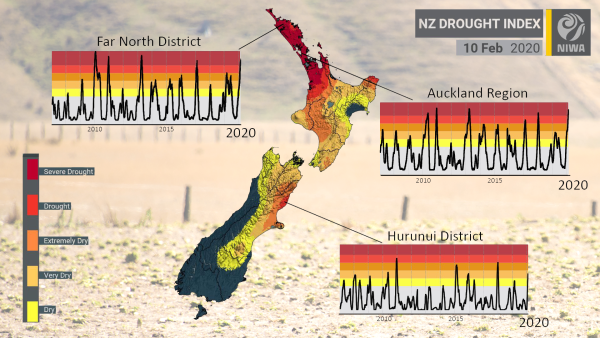Auckland is set to break a climate record on Saturday for the region’s longest dry spell, according to NIWA forecasters.
A dry spell is defined as consecutive days with less than 1 mm of rain and the current record for the greater Auckland area is 39 days. With no rain forecast before then, it is almost certain to become 40 days on Saturday, NIWA forecaster Ben Noll says.
Other recent dry spells across the country include:
- Whangarei – 29 days (since 15 Jan), the third longest on record and still ongoing
- Whitianga – 29 days (since 15 Jan), the third longest on record and still ongoing
- Takaka – 46 days (20 Dec-3 Feb), longest on record
- Blenheim – 55 days (since 20 Dec), longest on record and still ongoing
- Cheviot – 49 days (21 Dec-7 Feb), longest on record
- Culverden – 45 days (21 Dec-3 Feb), 2nd longest on record
- Rangiora – 45 days (21 Dec-3 Feb), 2nd longest on record
- Hanmer Forest – 40 days (26 Dec-3 Feb), longest on record.
The New Zealand Drought Index (www.niwa.co.nz/drought-index) shows severe meteorological drought is widespread across Northland, Auckland, and northern Waikato. Meteorological drought has also emerged in northern Gisborne and northern Canterbury. Much of the rest of the country is unusually dry, except for the western and lower South Island.
Mr Noll says the permanent wilting point, or minimum amount of water in the soil that a plant requires not to wilt or die, is being approached in Northland, Auckland, and Waikato.
The summer of 2012-13 featured one of the worst droughts in decades for parts of Northland, Auckland, Waikato, Bay of Plenty, Hawke’s Bay, and the western South Island.
“Soil moisture deficit levels during early 2020 are quite similar to 2013, with Northland’s deficits even more severe this year.”
Mr Noll says the drought has been caused by a blocking ridge of high pressure near the North Island that has helped steer dry, westerly quarter winds from Australia for much of the summer.
End in sight?
The drought will end when soil moisture levels return to normal. However, impacts of drought can continue for some time after that.
NIWA’s climate projections indicate that drought is likely to become more frequent and severe in eastern and northern parts of New Zealand in the coming decades.
Cyclone Uesi is expected to approach the South Island next week, bringing a likelihood for heavy rainfall. A moist, humid airmass coming with the cyclone could increase the chance for showers and thunderstorms for many parts of the country next week.

